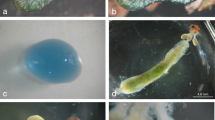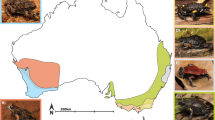Abstract
The larvae of the specialist sawflyRhadinoceraea nodicornis Konow (Hymenoptera, Tenthredinidae) store in their hemolymph ceveratrum alkaloids originating from the host plantVeratrum album L. (Liliales, Melanthiaceae). The major alkaloid found in the hemolymph is 3-acetyl-zygadenine. Qualitative and quantitative data showed that the plant alkaloid 3-angeloylzygadenine is most probably metabolized in the larval gut to zygadenine and then acetylated. A still unidentified alkaloid with a molecular weight of 591 Da was detected in plant leaves as well as in the gut, hemolymph, and excrement of larvae. Protoveratrine A and B, on the other hand, seem to be degraded by the larvae. These findings indicate that the pathway of ceveratrum alkaloids inR. nodicornis larvae is fourfold: direct sequestration, metabolism followed by sequestration, excretion of intact alkaloids, and degradation. In contrast, no ceveratrum alkaloids were detected in the hemolymph and excrement of larvae of the generalist sawflyAglaostigma sp. fed withV. album leaves. Bioassays with the antMyrmica rubra L. proved that the hemolymph ofR. nodicornis larvae is highly deterrent and toxic. In bioassays evaluating defensive efficiency against predators (ants, spiders, and bushcrickets), no larvae were eaten. Ceveratrum alkaloids were also detected in the hibernating prepupae ofR. nodicornis. In feeding bioassays, the shrewCrocidura russula Hermann rarely fed upon prepupae, suggesting that this stage is also protected from predation to some degree. In field surveys, the only parasitoids recorded were two ichneumonid species that are believed to be specialized onR. nodicornis. Bioassays and field observations enable us to suppose thatR. nodicornis and its enemies produce a food web of ion connectance.
Similar content being viewed by others
References
Aplin, R.T., Benn, M.H., andRothschild, M. 1968. Poisonous alkaloids in the body tissues of the cinnabar moth,Callimorpha jacobaeae (L.).Nature 219:747–748.
Benson, R.B. 1950. An introduction to the natural history of British sawflies (Hymenoptera, Symphyta).Trans. Soc. Br. Entomol. 10:45–142.
Bergmann, E.D., Levinson, Z.H., andMechoulam, R. 1958. The toxicity ofVeratrum andSolanum alkaloids to housefly larvae.J. Insect Physiol. 2:162–177.
Bernays, E., andGraham, M. 1988. On the evolution of host specifity in phytophagous arthropods.Ecology 69:886–892.
Binns, W., Keeler, R.F., andBalls, L.D. 1972. Congenital deformities in lambs, calves and goats resulting from maternal ingestion ofVeratrum californicum: Hare clip, cleft palate, ataxia and hypoplasia of metacarpal and metatarsal bones.Clin. Toxicol. 5:245–261.
Blum, M.S., Rivier, L., andPlowman, T. 1981. Fate of cocaine in the lymantriidEloria noyesi, a predator ofErythroxylum coca.Phytochemistry 20:2499–2500.
Boevé, J.-L. 1991. Gregariousness, field distribution and defence in the sawfly larvaeCroesus varus andC. septentrionalis (Hymenoptera, Tenthredinidae).Oecologia 85:440–446.
Boppré, M. 1986. Insects pharmacophagously utilizing defensive plant chemicals (pyrrolizidine alkaloids),Naturwissenschaften 73:17–26.
Bowers, M.D. 1990. Recycling plant natural products for insect defense, pp. 353–386,in D.L. Evans and J.O. Schmidt (eds.). Insect Defenses—Adaptive Mechanisms and Strategies of Prey and Predators. State University of New York Press, Albany.
Brown, K.S., Jr. 1984. Adult-obtained pyrrolizidine alkaloids defend ithomiine butterflies against a spider predator.Nature 309:707–709.
Crosby, D.G. 1971. Minor insecticides of plant origin, pp. 177–239,in M. Jacobsen and D.G. Crosby (eds.). Naturally occurring insecticides. Dekker, New York.
Edgar, J.A., andCulvenor, C.C.J. 1974. Pyrrolizidine ester alkaloid in danaid butterflies.Nature 248:614.
Fisher, R.A. 1940. Insecticidal action of extracts ofVeratrum viride.J. Econ. Entomol. 33:728–733.
Haas, H.T.H. 1938. Zur Pharmakologie des Germerins und seiner Spaltprodukte.Naunyn-Schmiedebergs Arch. Exp. Pathol. Pharmakol. 189:397.
Heads, P.A., andLawton, J.H. 1985. Bracken, ants and extrafloral nectaries. III. How insect herbivores avoid ant predation.Ecol. Entomol. 10:29–42.
Hegnauer, R. 1988. Biochemistry, distribution and taxonomic relevance of higher plant alkaloids.Phytochemistry 27:2423–2427.
Honerjäger, P., Frelin, C., andLazdunski, M. 1982. Actions, interactions, and apparent affinities of various ceveratrum alkaloids at sodium channels of cultured neuroblastoma and cardiac cells.Naunyn-Schmiedeberg's Arch. Pharmakol. 321:123–129.
Kupchan, S.M., Zimmerman, J.H., andAfonso, A. 1961. The alkaloids and taxonomy ofVeratrum and related genera.Lloydia 24:1–26.
Lorenz H., andKraus, M. 1957. Die Larvalsystematik der Blattwespen (Tenthredinoidea und Megalodontoidea). Academie Verlag, Berlin.
Majak, W., McDiarmid, R.E., Cristofoli, W., Sun, F., andBenn, M. 1992. Content of zygacine inZygadenus venenosus at different stages of growth.Phytochemistry 31:3417–3418.
Metcalf, R.L. 1977. Plant derivatives for insect control.Abstr. Trop. Agric. 5:165–177.
Nagasaka, K. 1991. Crucial factors determining the spatio-temporal distribution patterns of threeAthalia sawflies feeding on common cruciferous plants.Res. Popul. Ecol. 33:115–128.
Pasteels, J.M., Daloze, D., andRowell-Rahier, M. 1986. Chemical defence in chrysomelid eggs and neonate larvae.Physiol. Entomol. 11:29–37.
Pasteels, J.M., Rowell-Rahier, M., andRaupp, M.J. 1988. Plant-derived defense in chrysomelid beetles, pp. 235–272,in P. Barbosa and D. Letourneau (eds.). Novel Aspects of Insect-Plant Interactions. Wiley, New York.
Price, P.W., Bouton, C.E., Gross, P., McPheron, B.A., Thompson, J.N., andWeis, A.E. 1980. Interactions among three trophic levels: influence of plants on interactions between insect herbivores and natural enemies.Annu. Rev. Ecol. Syst. 1980:41–65.
Rothschild, M. 1972. Secondary plant substances and warning colouration in insects.Symp. R. Entomol. Soc. London 6:59–83.
Rothschild, M., Aplin, R.T., Cockrum, P.A., Edgar, J.A., Fairweather, P., andLees, R. 1979. Pyrrolizidine alkaloids in arctiid moths (Lep.) with a discussion on host plant relationships and the role of these secondary plant substances in the Arctiidae.Biol. J. Linn. Soc. 12:305–326.
Rowell-Rahier, M., andPasteels, J.M. 1992. Third trophic level influences of plant allelochemicals, pp. 243–277,in G.A. Rosenthal and M.R. Berenbaum (eds.). Herbivores, Their Interactions with Secondary Plant Metabolites. Academic Press, London.
Schedl, W. 1991. Hymenoptera, Unterordnung Symphyta. Walter de Gruyter, Berlin.
Smith, D.R., andMcDearman, W. 1990. A newRhadinoceraea (Hymenoptera: Tenthredinidae) feeding onZigadenus (Liliaceae) from southeastern United States.Entomol. News 101:13–19.
Teuscher, E., andLindequist, U. 1987. Biogene Gifte. Gustaf Fischer Verlag, Stuttgart.
Ujvary, I., Eya, B.K., Grendell, R.L., Toia, R.F., andCasida, J.E. 1991. Insecticidal activity of various 3-acyl and other derivatives of veracevine relative to theVeratrum alkaloids veratridine and cevadine.J. Agric. Food Chem. 39:1875–1881.
Velbinger, H.H. 1947. Veratrin-Intoxikation bei Insekten. Beitrag zur Toxikologie der Alkaloide.Süddtsch. Apoth. Zitg. 9:89–95.
Wink, M. 1992. The role of quinolizidine alkaloids in plant-insect interactions, pp. 131–166,in E. Bernays (ed.). Insect-Plant Interactions. Vol. IV. CRC Press, Boca Raton, Florida.
Author information
Authors and Affiliations
Rights and permissions
About this article
Cite this article
Schaffner, U., Boevé, JL., Gfeller, H. et al. Sequestration ofVeratrum alkaloids by specialistRhadinoceraea nodicornis konow (Hymenoptera, Tenthredinidae) and its ecoethological implications. J Chem Ecol 20, 3233–3250 (1994). https://doi.org/10.1007/BF02033723
Received:
Accepted:
Issue Date:
DOI: https://doi.org/10.1007/BF02033723




